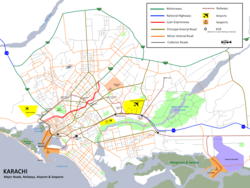Manghopir: Difference between revisions
m CambridgeBayWeather moved page Manghopir Town to Manghopir over redirect: Remove unnecessary parentheses/disambiguator |
No edit summary Tags: Reverted Visual edit Mobile edit Mobile web edit Advanced mobile edit |
||
| Line 29: | Line 29: | ||
Manghopir is mostly inhabited by one of [[Pakistan]]'s smallest ethnic communities, the [[Sheedi]], also known as Makrani. Sheedi are said to be the descendants of [[Afro-Arab]]s from [[Zanzibar]] and maintain their distinct [[Afro-Arab]] and [[Oman]]i identity in the midst of the dominating South [[Culture of Asia|Asian cultures]]. |
Manghopir is mostly inhabited by one of [[Pakistan]]'s smallest ethnic communities, the [[Sheedi]], also known as Makrani. Sheedi are said to be the descendants of [[Afro-Arab]]s from [[Zanzibar]] and maintain their distinct [[Afro-Arab]] and [[Oman]]i identity in the midst of the dominating South [[Culture of Asia|Asian cultures]]. |
||
Presently, these African-Pakistanis live in various parts of [[Karachi]]. Most are found in [[Lyari]], but they are also found in [[Malir]], Moaach Goth, Manghopir, and further interior at [[Sindh]] and [[Balochistan (Pakistan)|Balochistan]]. Due to Lyari's dominant [[Sheedi people]] population, it is often called 'Little Africa'. Some [[Afro-Arab]] style festivals and dances like |
Presently, these African-Pakistanis live in various parts of [[Karachi]]. Most are found in [[Lyari]], but they are also found in [[Malir]], Moaach Goth, Manghopir, and further interior at [[Sindh]] and [[Balochistan (Pakistan)|Balochistan]]. Due to Lyari's dominant [[Sheedi people]] population, it is often called 'Little Africa'. Some [[Afro-Arab]] style festivals and dances like Gowaati, [[Liwa (music)|Lewa]], [[Dhamaal]], beating Omani style shindo, jabwah, and jasser [[conga drum|drum]]s are still popular in Manghopirs Lyari locale. Many forms of folk beliefs and medicines are also still practiced. A prominent [[Urdu]] poet and Lyari citizen, [[Noon Meem Danish]], proudly claims to be the great-great-grandchild of an African from [[Zanzibar]]. "Now after centuries of cultural amalgamation, Sheedis proudly call themselves Baloch or Makrani." |
||
==See also== |
==See also== |
||
Revision as of 20:09, 12 April 2024

Manghopir Town (Urdu: منگھوپیر ٹاؤن) is a neighbourhood in the Orangi District of Karachi, Sindh, Pakistan, that previously was a part of Gadap Town until 2011, now it is one of the three towns of Orangi District of Karachi. [1]
Demographics
There are several ethnic groups in Manghopir including Muhajirs, Punjabis, Kashmiris, Seraikis, Pakhtuns, Balochis, Memons, Bohras, Ismailis, etc. The population of the neighborhood is Muslim.
Manghopir is a rural area of Karachi, The area has the oldest Sufi shrines in the city named after a Hindu Saint saqib, hot sulphur springs that are believed to have curative powers, and many crocodiles - believed locally to be the sacred disciples of Pir Mangho.[citation needed] Balochs often call this place as ‘Mangi’ or Garm-aab / Sard-aab (due to the presence of the hot & cold springs).[citation needed] [citation needed]
Manghopir Lake

The Manghopir Lake is situated near the shrine of Sufi Pir Mangho and there over one hundred Mugger crocodiles in the lake which are fed by the pilgrims.[2]
Sheedis and Festivals
Manghopir is mostly inhabited by one of Pakistan's smallest ethnic communities, the Sheedi, also known as Makrani. Sheedi are said to be the descendants of Afro-Arabs from Zanzibar and maintain their distinct Afro-Arab and Omani identity in the midst of the dominating South Asian cultures.
Presently, these African-Pakistanis live in various parts of Karachi. Most are found in Lyari, but they are also found in Malir, Moaach Goth, Manghopir, and further interior at Sindh and Balochistan. Due to Lyari's dominant Sheedi people population, it is often called 'Little Africa'. Some Afro-Arab style festivals and dances like Gowaati, Lewa, Dhamaal, beating Omani style shindo, jabwah, and jasser drums are still popular in Manghopirs Lyari locale. Many forms of folk beliefs and medicines are also still practiced. A prominent Urdu poet and Lyari citizen, Noon Meem Danish, proudly claims to be the great-great-grandchild of an African from Zanzibar. "Now after centuries of cultural amalgamation, Sheedis proudly call themselves Baloch or Makrani."
See also
References
- ^ Baldia Town Archived 2006-02-19 at the Wayback Machine
- ^ Runaway crocodiles returned to Manghopir shrine

